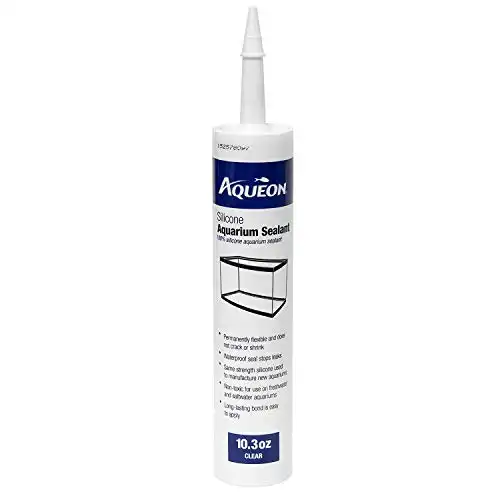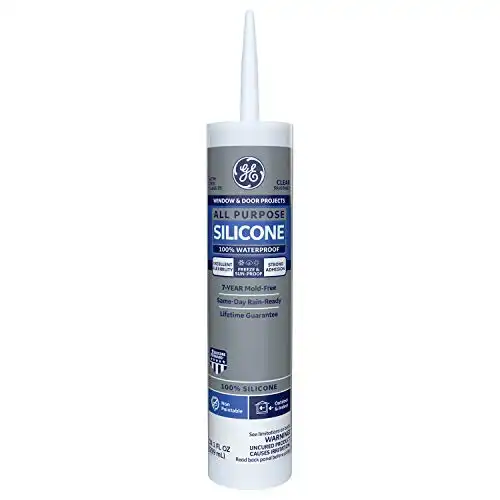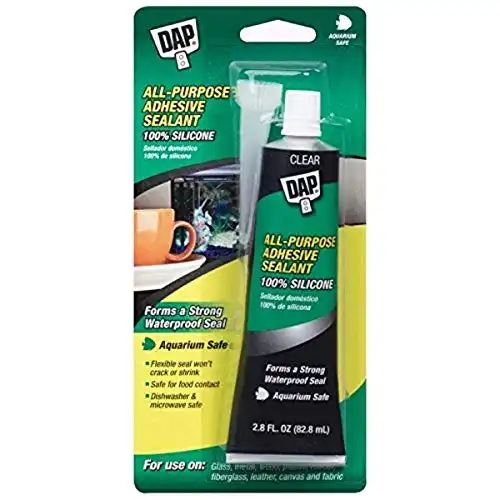If you are building your first gecko tank, especially if you are a DIYer like myself, very likely you are going to need some silicone. However, using silicone for a windowsill is way different than a silicone for your gecko tank.
The silicon I would recommend for a gecko tank is the Aqueon Fish Tank Silicone. This silicon is designed to be safe while in constant contact with water, where marine life such as reptiles (as well as other pets such as fish and turtles).
There is also a more affordable alternative, however, for those, you need to spend a bit of extra time checking the label to avoid potentially hazardous substances.
Description: This aquarium safe silicon is a proven safe silicon for tank that are going to be used for aquatic animal and our geckos | Description: The multipurpose silicone not always is a good option for geckos. The one here recommended has been used by other of our friends and gecko owners. |
This aquarium safe silicon is a proven safe silicon for tank that are going to be used for aquatic animal and our geckos
The multipurpose silicone not always is a good option for geckos. The one here recommended has been used by other of our friends and gecko owners.
Silicones That Can Be Used In Gecko’s Tanks
- Aquarium Safe Silicone (best overall)
- Multipurpose Silicone (cheapest, but careful to the label)
Aquarium Safe Silicone
Of course, not all all-purpose silicone sealants and adhesives are safe for our precious gecko buddies. For this reason alone, many other hobbyists prefer using things that are proven safe for the most sensitive animals such as fish and corals. (Yes, you read that right. Corals are animals and not plants.)
Multiple brands offer RTV silicones that are specifically made for aquarium building and decorating like this on Amazon. I’ve also checked its MSDS and it’s all good – chemically stable and doesn’t contain any toxic additives or catalysts.
Aquarium silicone is usually more expensive than generic all-purpose silicone. Another downside is it’s mostly only applicable for use on glass materials. It is designed for animals in constant contact with water and potentially silicone, it’s safe to say that aquarium silicone won’t cause any health problems for terrestrial and arboreal geckos.
It normally doesn’t have any other additive in it that could continuously leech out even when submerged in water either. Aquarium silicone is also proven to be 100% non-toxic and biocompatible after curing. So don’t let the price tag stop you from making sure your gecko is safe and healthy.
Multipurpose Silicone
All-purpose silicones top my list of great silicones for gecko enclosures because they’re the cheapest and easiest to find. Most professional vivarium builders also recommend this.
This type of silicone product usually has much more fillers compared to others creating a cured rubber that’s much more durable. It’s great to use as a sealant and an adhesive. They may also have other compounds added to them to improve certain qualities.
In general I always recommend to check the ingredients list for possible hazards (you can find more info on such types of hazards in the list at the end of the article). The one I recommended is also used by some of my friends with an aquarium, so it should not be a problem for gecko (after of course leaving a few days for the silicone to totally dry in a well-treated place).
Usually, all-purpose silicone is also compatible with a variety of building materials. You can use it on metal, wood, stone, cement, plaster, brick, glass, and a bunch of other things. So as the name suggests, you can use it in many different gecko tank projects.
Different brands also offer this silicone in different colors. Some hobbyists prefer using brown and black silicones so that their projects still look aesthetically pleasing even when some of the materials they’ve glued onto them get removed or fall off. However, I like playing things safe and usually stick to clear ones.
You can find this in your local hardware stores and even in a supermarket or on Amazon. I particularly love it because I know it’s the safest option for all-purpose silicone sealants and adhesives. I checked its MSDS and it’s all good. It is also used by many people for their gecko vivarium and aquarium.
How To Choose The Silicone For Gecko’s Tanks?
Once you have a gecko of your own, I’m sure you’ll be constantly thinking of what projects you can do to make your little friend feel right at home. However, many of the things we never really think twice about using in our own homes could possibly be dangerous for our geckos – so what silicones should you use for your tank?
Silicones safe for gecko tanks are 1) all-purpose, 2) aquarium-safe, or 3) food-grade. These are room-temperature vulcanizing types that contain silicone, silica fillers, and an acetoxy curing agent. Avoid silicones with 1) fungicides, 2) organotin, 3) alcohol, 4) neutral cure agents, 5) arsenic, or 6) ammonia.
Stick around as I get into the meat of it all and find out what silicone to use for your next project!
Silicone Features For Tanks
People unfamiliar with keeping geckos seem to think that a bare enclosure outfitted with only a hide and a feeding dish is enough for these lovely creatures to thrive. But that couldn’t be any farther from the truth. Geckos need entertainment, and enrichment, just as humans do in their homes. So it’s important to learn what materials are safe whenever you’re doing DIYs for your geckos to live happily in captivity.
Let’s familiarize ourselves with silicone to find out how we can bring out its maximum potential. To do that, I’ve listed the many significant properties of pure silicone [1]:
- It remains chemically stable in a very wide range of temperatures.
- It has low thermal conductivity making it a great insulating material.
- It’s widely considered to be virtually non-toxic.
- It repels water instead of absorbing it, perfect for sealing other materials.
- It’s inherently anti-microbial.
- It’s largely unreactive to many other substances
- It remains mostly unaffected even after exposure to ozone and ultraviolet (UV) light.
- It has high gas permeability.
- It’s extremely malleable.
- It adheres well to several materials including glass.
In combination with other elements and substances, silicone can also be made to fit your specific needs and requirements. For example, it could be formulated to either conduct or insulate electricity.
Commercially available silicones usually have fillers and curing agents or catalysts in them. Some even have dyes and other added chemicals in them to add color and make it more adhesive to a variety of different.
Uses of Silicone in Your Gecko Tank!
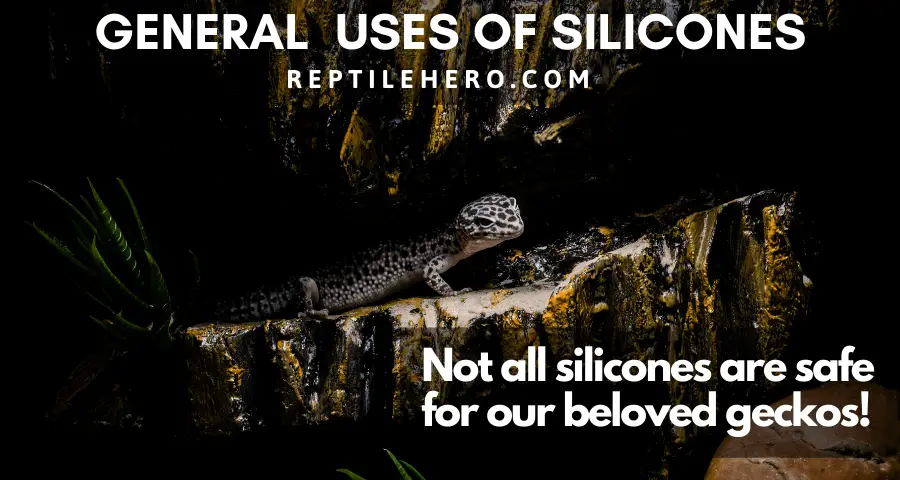
As I’ve already mentioned in previous sections of the article, silicone is an incredibly versatile raw material. When manipulated in certain ways or combined with other substances it can be used in almost every practice there is. Once processed, silicone is available as an oil, grease, paste, rubber, resin, or caulk.
Silicone can be used for simple everyday household items and complex large-scale industrial applications. Of course, silicone is also used to make the lives of many pets – geckos included – much more comfortable and enjoyable!
For your gecko vivariums, you can use silicone as both a sealant and an adhesive. Many gecko hobbyists have used it for projects on water features, feedings dishes, and custom enclosures as well as for repairing cracks, holes, and seals.
However, not all silicones are created equal. A silicone used for airplanes may not be safe for your gecko. To reiterate, silicone on its own is totally safe. It’s the other things added to them that could pose problems.
I’m going to let you in on a little secret. Even if the silicone you buy has “100%” all over it, once you check its material safety data sheet (MSDS) you’ll realize it usually actually isn’t. Is this a bad thing? Well, no. But it isn’t really a good thing either.
The Silicones You Can Use For Your Gecko’s Tank
Now I’m going to give you my top 3 choices for room temperature vulcanizing (RTV) silicone whenever I’m doing projects for my gecko’s vivarium. All of these are acetoxy cure silicones so they will smell a lot until they’re fully dry inside out.
Axetocy cure RTV silicones that have cured completely become a hardened rubbery material that’s a mixture of just silicone and some type of filler like silica. They are non-toxic and safe to use in gecko tanks even for prolonged or chronic exposure to humid environments as they are biocompatible.
The pungent vinegar scent could be unpleasant during application but it’s relatively harmless and it’s easier to tell when these silicones are fully vulcanized because it then becomes odorless. Being exposed to a dried acetoxy cure RTV silicone frequently doesn’t pose any risks either because the acetic acid it gives off is usually the only substance in there that has the potential to cause you some minor discomfort and irritation [2].
You can use it to create DIY feeding bowls, water features, backgrounds, hides, and loads of other cool stuff to make your gecko feel right at home. I mean just look at this gorgeous custom naturalistic vivarium set-up created with the help of some silicone:
Usually, a thin application in industrial settings can finish off-gassing in just 24 hours (1 day) or less. However, most experienced breeders and long-time keepers advise to let tank projects with silicone cure for at least 72 hours (3 days) or more even when the silicone has lost all that sharp vinegar smell.
If you’re planning to buy any of the silicones I recommend in a cartridge, add a caulking gun as well for an easier and cleaner application.
The Third Type of Silicone: The Food-Safe Silicone
Another type of silicone that can be used in gecko’s tank is the RTV silicone, this is food-contact-safe. This is definitely the most expensive one. But I do think that there is a reason behind its high pricing.
Food-safe silicone does not produce considerable amounts of formaldehyde vapors when exposed to temperatures over 300°F (150°C) to cause acute toxicity. This could explain why they’re usually dishwasher and microwave safe.
However, I’m no chemist so I may not be completely correct on that. Also, I’d rather you err on the side of caution so don’t stick your DIY feeding and drinking dishes into the oven for a faster cure. Just let them air out in a well-ventilated area.
Moreover, since geckos should never be kept in environments of such extreme temperatures that bring about the generation of formaldehyde from the degradation of silicone, they are generally safe even when exposed to food and water.
Inside gecko vivarium, food-safe silicone is perfect for creating natural-looking facades for DIY water features or recycled food, supplement, and vitamin dishes like bottle caps and jar lids.
For small and specific projects like these, I prefer buying just a small tube of silicone like the one below. As with all my other recommendations, I’ve also checked its MSDS for possible toxicity and health hazards. The good news is it’s completely safe and without dangerous additives whatsoever.
6 Silicones to Avoid Using in Gecko’s Tanks
So yeah, even if that expensive tube of silicone is marketed as being purely silicone and silicone alone, it’s probably not true. However, having additives doesn’t make RTV silicones dangerous per se since fillers (e.g., silica) are usually added to increase tensile strength while catalysts could affect the length of time needed for full curing [3].
Always take the time to check the labels – make it a habit. If it has “mold/mildew resistant” on it, clarify whether or not it contains additional antifungal compounds because as I have said before, pure silicone is inherently antimicrobial (though only to a limited degree).
On the condition that you don’t see the complete list of the ingredients for the tube of RTV silicone you are planning to buy, contact their manufacturers via email or phone. My friends have done it before and most companies are responsive.
Without further ado, here’s a short list of things silicones should look out for.
#1 – Silicone With Fungicide
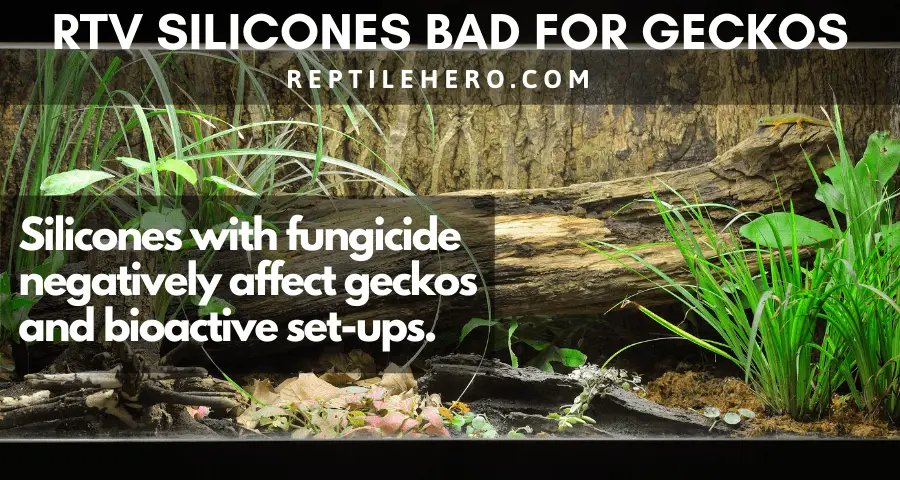
Hypothetically speaking, this is actually useful in deterring mold and mildew formation as it continuously releases antifungal chemicals even long after vulcanizing.
Kitchen, bathroom, and sanitary silicones usually have this to prevent microbiological growth on the skin or outer layer of the silicone even when exposed to highly humid environments and frequently contaminated by the build-up of dirt, soap, etc.
However, this is known to kill off not just bad microorganisms but good ones as well – those essential to maintain a healthy bioactive vivarium set-up.
#2 – Silicone With Organotin Condensation Catalyst
Organotin condensation catalysts are compounds added to silicone to either reduce or completely remove the strong vinegary byproduct of the curing process. It’s great in theory because you won’t have to deal with any smell whatsoever.
Specifically, because it doesn’t smell much, it’s tougher to tell whether it has only finished skinning (meaning hardened outside but not thoroughly) or if it’s actually done curing.
Experts in the animal-keeping community, as well as scientists, have also pointed out that it has been documented to cause a few health issues, though documentation is quite scarce [4].
#3 – Silicone With Alcohol
Considering how damaging alcohol could be to our skin, imagine how much more drying and harmful it would be to reptile babies.
Moreover, the presence and condensation of alcohol may compromise the integrity of the forming silicone rubber and cause it to weaken quickly. This is commonly present in silicone products that utilize organotin agents.
#4 – Silicone With Neutral Cure Agents
Although RTV silicones that use neutral cure agents are pretty much odorless and non-corrosive when used on metals, that doesn’t mean it’s necessarily safe for you or your gecko because silicones with such agents usually let off chemicals such as methyl ethyl ketoxime (MEKO) and acetone.
Both can cause dizziness or minor skin and eye irritation [2]. In concentrated quantities, MEKO seems to have carcinogenic properties. Even acetone, a solvent with relatively low toxicity, has been shown to disrupt normal neurological behaviors and negatively affect female reproduction.
#5 – Silicone With Arsenic
Arsenic is a naturally occurring element on Earth similar to silicone. However, unlike silicone, arsenic is known to be extremely dangerous even when only found in trace amounts. As a matter of fact, it’s usually used as a pesticide. It’s highly toxic and also considered an environmental hazard [2].
#6 – Silicone With Ammonia
Stay clear of silicones that contain or release ammonia as well. Sure, it’s natural however that doesn’t instantly mean it’s without any negative effects. In reality, ammonia has a number of serious dangers for you, your pet gecko, and the environment. It’s incredibly corrosive and toxic [2].
3 Practical Tips for Using Silicone in Your Gecko’s Tank
I know I said that acetoxy cure RTV silicone sealants and adhesives are relatively harmless materials to work with. However, there’s no harm in being extra cautious and careful whenever handling construction products. It’s always better safe than sorry, right?
So here are some important tips to keep in mind if you plan to use silicone on your next gecko tank project:
- Wear protective gear. Okay, I know it sounds a bit over-the-top, but most experts still recommend the use of nitrile gloves, face masks, and safety glasses even in recreational settings.
- Stay in a well-ventilated working space. Doing this will prevent the build-up of vapors and lessen curing time. If you don’t have a backyard or a balcony to leave your projects in, you can just let it vulcanize in a room with open windows and working fans to ensure that the air is properly circulating.
- Let silicone cure for at least 72 hours (3 days) at room temperature. If it’s relatively cold all-year-round in your area, curing time may take even longer. However, it’s essential to let silicone cure completely for it to be safe for geckos, plants, insects, isopods, and other good microorganisms.
Here’s another cool gecko vivarium with a water feature built using silicone:
Silicon or Silicone: Which is Which?
Many people use silicon and silicone interchangeably. I used to think they were the same thing as well. I thought they were just another one of those pairs of English words that are spelled with an extra letter in other countries – like color and colour. But are they actually the same thing? The answer is: no, they’re not.
Silicon is a dark gray-blue semiconducting crystalline metalloid that occurs naturally on our planet. This means it possesses characteristics of both metal and non-metal elements.
Interestingly, even though it’s the second most abundant element found in the Earth’s crust, it’s rarely seen in its purest form because it easily bonds with oxygen (the most abundant element). So we usually see this fascinating chemical substance as silicone dioxide, more commonly known as either silica or quartz [5].
Silicone, on the other hand, is an elastic synthetic polymer composed mainly of silicon, oxygen, carbon, and hydrogen, or some other organic element [6]. This chain of elements is otherwise referred to as siloxane. Physically, it’s an odorless and colorless flexible substance that’s either a viscous liquid or a rubbery solid. Like silicone, this man-made material also has a variety of applications.
Silicon is one of the many natural elements that comprise the numerous chains of siloxane that form synthetic silicone. Both of these materials are utilized for different reasons in diverse ways.
Takeaways
Silicon and silicone are both very different things, the former being natural and the latter being artificial. However, both compounds are highly versatile and are used in many industries and professions.
Generally, silicone products that are all-purpose, safe for aquariums, and food-safe produce a non-toxic and biocompatible rubbery material safe for geckos.
Not all commercially available silicones are safe for geckos, some may contain highly toxic and hazardous chemicals which could hurt or even kill your pet.
When using silicone in your tank builds and other gecko projects, wear protective gear, stay in a well-ventilated area, and let it cure for at least 3 days.
Sources
[1] https://pubchem.ncbi.nlm.nih.gov/
[2] https://onlinelibrary.wiley.com/doi/abs/10.1002/14356007.a24_057
[3] https://www.ncbi.nlm.nih.gov/pmc/articles/PMC4129753/
[5] https://minds.wisconsin.edu/bitstream/handle/1793/11591/Silicon.pdf?sequence=1%20

